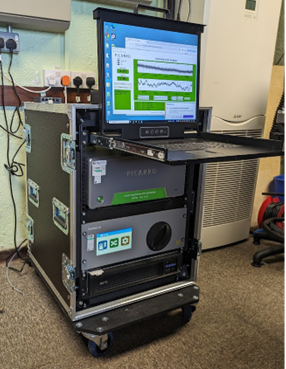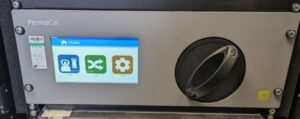Instrument Support Level 6
Picarro G2103
£90,000
G2103 Analyser (D x W x H) 44.5 cm x 43.2 cm x 17.8 cm, 20.9 kg; Pump (D x W x H) 27.9 cm x 10.2 cm x 19.1 cm
74 cm x 50.7 cm x 78 cm (91 cm with castors)
£30
Calendar

Picarro G2103 CRDS
The Picarro G2103 gas concentration analyser provides precise, real-time measurement of ammonia (NH3) and water (H2O) vapor. It incorporates coated components in the critical gas pathway. This reduces the propensity of NH3 molecules to adhere to pathway surfaces, which improves measurement response time. The analyser is an ideal solution for sensitive trace and ambient ammonia research and monitoring applications, such as livestock emissions on farms and formation of particle matters from ammonia in urban areas.
Fast, continuous, real-time measurement of NH3
Long-term stability for infrequent calibration
Water correction automatically reports dry gas amount fractions
Precision at 1 second, 10 seconds, and 5 minutes is 500, 170, and 30 and parts-per-trillion (ppt)
Drift at standard temperature and pressure (STP) over 72 hours is ± 0.15 ppb.
Water correction software automatically reports dry gas mole fractions to help reduce research complexity and consumable costs.
The instrument is housed in a custom-built shipping case. This case contains a fold away display. In addition, the case contains a built in UPS unit (APC Smart-UPS 3000VA) to mitigate against short term power outages whist operating in the field.
Please note that a display, keyboard, and mouse will need to be sourced if the analyser is shipped outside of its case.
Optional extras
5 m temperature-controlled PTFE inlet line
High flow KNF pumps for low sample residence time in inlet line
LNI Swissgas PermaCal permeation oven (available through separate AMOF application)
Ammonia permeation tube
The instrument is calibrated using a gas permeation source (LNI Swissgas, PermaCal 1). The PermaCal is built into the same transport case as the G2103 analyser and it is generally assumed that both the analyser and PermaCal will be used together. Please ask for further information about calibration ranges.
The user will need to supply (otherwise will be charged for):
Zero air
Zeroing scrubber material: typically
Phosphoric Acid Impregnated Activated Carbon (PAIAC)
Teflon filters
Instrument Insurance
This system must be insured by the user for £90K and covers loss, theft or damage to the instrument: damage is that over and above general wear and tear. The system has been designed to be rugged and autonomous. Even so, the end-user must respect the fact that the system is a precision optical instrument that must be treated with great care.
The user is responsible for the instrument from the time it leaves the AMOF to the time it is returned and signed off as in an acceptable operating condition by the IS: this will be done as soon as is possible on its return.
Public Liability Insurance
The AMOF is not liable for any damage or injury arising from the deployment or operation of this instrument when unattended by the IS.
Shipping Expenses
The user is liable for all costs arising from the shipping of the instrument both to and from a deployment.
IS T&S
The user is responsible for coving the travel and subsistence expenses of the IS while attending the instrument.
The system when packed ready for shipping consists of a single case:
Shipping dimensions (in case):
74 cm x 50.7 cm x 78 cm (91 cm with castors)
Ideally, the analyser should be operated from an air-conditioned laboratory, measurements taken at atmospheric pressure. It is advisable to use the shortest inlet line possible with a large flow rate to limit residence times.
Manual handling
For the safest operation, leave the analyser in the shipping case during operation.
If needed,
A procedure appropriate to lifting a heavy object should be used when lifting the analyzer. This procedure consists of bending at the knees while keeping your back straight and upright.
The analyzer should be grasped at the bottom, in the front and at the rear of the unit.
Do not attempt to lift the analyzer by the cover or other external fittings.
While one person may lift the unit, it is desirable to have two persons lifting,
one by grasping the bottom in the front and the other by grasping the bottom in the rear.
Cables and sample tubing kept away from pathways; held overhead height if necessary.
Walkways kept free of clutter and access to exit kept clear.
Laser safety
This equipment is classified as a Class 1 laser product with an embedded 3B laser in accordance with EN 60825-1:2014. Do not to open the enclosure where this label is placed; there are no user serviceable parts inside.
Electric safety
Attach all cables to analyser before switching on at the mains.
All equipment electrical safety tested.
Under no circumstances should the user remove the out casing of the analyser whilst it is connected to a mains supply.
Attended operation
There is no requirement for the system to be attended during operation from a safety standpoint.
Power Requirements (G2103 and pump only)
Power
100 –240 VAC; 47 –63 Hz (auto-sensing)
Startup power
<375 W at start-up, (Analyzer and Pump)
Steady state power
120 W (Analyzer)
150 W (A2000 Pump)
Operation temperature:
Operating: 10 °C to 35 °C (50 °F to 95 °F)
Storage: -10 °C to 50 °C (14 °F to 122 °F)
Data is provided in NetCDF files following the AMOF data standard
Instrument name is amof-nh3-1
The data product(s) associated with this instrument:
nh3-concentration
Example data file
